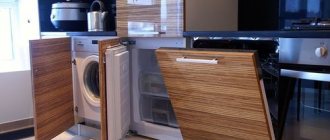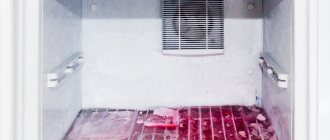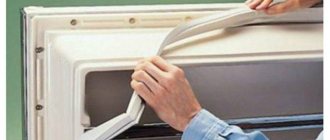The main problem of many Russian apartments is a small kitchen. Therefore, when buying a refrigerator or freezer, many are faced with a seemingly insoluble problem - where to put it? And then it comes to mind that you have a completely unoccupied balcony (or loggia), and you decide to install a refrigerator there! But wait... Is it even possible to place a refrigerator on the balcony, and will it work there? Let's try to understand this issue.
What do manufacturers recommend?
One of the important characteristics of a refrigerator is the climate class, which shows at what ambient temperature the normal operation of the unit is guaranteed (read more about this in the article “What does the climate class of a refrigerator mean”). Manufacturers prescribe operating refrigerators in the temperature range from +16 to +32 °C (normal climate class N). Some models can operate at temperatures from +10 to +43 °C (universal climate class SN-T). Failure to comply with these requirements may result in unstable operation of the unit. Moreover, if a breakdown occurs due to non-compliance with the recommended operating conditions, the manufacturer has every right to refuse you warranty repairs.
Conclusion: Operating a refrigerator on an unheated balcony or loggia (even if it is glazed) will most likely lead to a violation of the temperature regime recommended by the manufacturer (in autumn, winter and spring the temperature may well be below 10 ° C, and in summer it may exceed 40 ° C above zero ).
Why use a refrigerator or freezer on the balcony: main reasons
- Exposure to precipitation on an unglazed balcony. When installing a refrigerator on an unglazed balcony, direct moisture on the unit threatens the electrical safety of the entire apartment: this can lead to a short circuit. In addition, in conditions of constant exposure to moisture, corrosion of metal parts is inevitable.
- High humidity. Operating a refrigeration unit in conditions of high humidity can lead to damage to electrical insulation, premature corrosion of metal parts of the refrigerator, swelling of the paintwork, etc. In addition, exposure to moisture can cause damage to the thermostat or control board of the refrigerator (due to oxidation of the contacts).
- Exposure to direct sunlight and high temperatures. Installing the refrigerator in an area exposed to direct sunlight will inevitably lead to fading of the paintwork of the unit - the paint will turn yellow and crack, and damage to plastic and rubber parts. In addition, in the summer, it is possible that the temperature at which the refrigerator can be operated is exceeded, which will force the compressor to work at its limit and may cause it to fail.
- Exposure to negative temperatures. During the cold season, the oil in the refrigerator compressor thickens, which puts additional stress on the motor and shortens its service life. In addition, at low ambient temperatures, the pressure in the line drops, and the freon collected in the condenser is initially unable to leave it. Therefore, the refrigerator motor will run idle for some time to create sufficient pressure. This also leads to overload of the compressor and premature failure.
Storing a non-working freezer in winter
Sometimes a family needs to store freezer equipment in a non-working state; the best solution is to take it outside the apartment, for example to a loggia, where there is enough free space. Such storage in the summer is possible on open and closed balconies, as well as in winter.
Related article: DIY New Year's crafts
A non-working freezing unit in winter can be installed even on an uninsulated balcony, you just need to carefully pack the equipment and protect it from moisture and dust.
You should carefully select a place for the freezer where slanting rain, other precipitation, dust and dirt will not reach.
Will a refrigerator or freezer work on a balcony in winter?
The purpose of a refrigerator is to cool; it technically cannot work to heat. Therefore, when the air temperature on the balcony drops to negative values, do not expect that the refrigerator will be warm, it will simply stop working. But with the freezer everything is not so clear. Depends on the design of the refrigerator. And the region of residence also plays a role. Let's look at the possible options.
- Single-compressor refrigerator with independent temperature control in the chambers (drip defrosting system in the refrigerator compartment and manual defrosting or NO Frost in the freezer). Most modern refrigerators are designed according to this principle. The compressor in units of this type is turned on by the “crying” evaporator sensor, which is triggered when the temperature rises to +4 – +10 °C. If the temperature on the balcony or loggia is below these values, the refrigerator, including the freezer, simply will not turn on and fulfill its main purpose.
- A single-compressor refrigerator with one thermostat, which simultaneously regulates the temperature in both chambers of the unit. In refrigerators of this design, the thermostat measures the temperature in the refrigerator evaporator and operates at a slightly positive temperature - from +4 to +7 °C. Accordingly, the behavior of such models is similar to the previous option: when the ambient temperature drops below this temperature, the compressor of the unit will not start and the refrigerator will not work.
- “FULL NO FROST” refrigerators and two-compressor units. The inclusion of cooling in the freezer compartment of such refrigerators is regulated by a separate temperature sensor located either in the evaporator of the freezer compartment or in the freezer itself. Its cooling mode is activated when the temperature rises to values from -16 to -24 °C (depending on the selected program). Thus, the freezer in such models can easily work on the balcony even in winter (if the frosts in your region are not too severe). However, switching cycles will be rare, and the compressor will experience a significant load (the oil will cool and thicken during shutdown). The refrigerator compartment will turn off at a temperature on the balcony from +4 to +10 ° C for the same reasons as above.
- Freezers and chest freezers. The operating temperature inside the freezer ranges from -18 to -24 degrees (depending on the selected cooling mode). Accordingly, as long as the temperature on the balcony is above the specified range, the freezer will turn on. But no one has canceled the excessive load on the compressor due to cold oil.
Operational requirements of the equipment
Certain characteristics of the device do not allow the freezer to be used on a loggia in principle, although each rule has its exceptions. After all, one of the main conditions for successful use is maintaining the appropriate temperature range. If the temperature is constantly changing, and condensation and dust accumulate on the body, then the performance of the equipment will be extremely low.
Damage can also occur due to direct exposure to sunlight , because overheating is destructive for such equipment - it causes the refrigerant to heat up and cause malfunctions.
Important: Much depends on the specific manufacturer. Some models cannot withstand low temperatures at all, and some will work in such conditions, but only for a limited time, that is, the overall service life will be reduced.
The operational differences are explained very simply - different oils are used for different models. It could be:
- synthetic. Remains operational within the range of -3...-5 degrees;
- mineral. Thickens quickly when the temperature drops below zero;
- polyester;
- polyvinyl ester. The most modern solution suitable for working in harsh conditions.
Almost all models of freezers are designed for use at above-zero temperatures. The following climate classes are distinguished:
- N, normal – temperature within +16…+32;
- SN, subnormal - from +18 to +38;
- ST, subtropical - +18…+ 38;
- T, tropical - +18…+ 43.
In addition, a special refrigerant is selected for each climate class of equipment. As a rule, it is designed for circulation at positive temperatures and will not function properly in the cold .
As we found out, the best option for placing a freezer is in a warm room. Step-by-step instructions for insulating a loggia with your own hands may be useful in this matter.
In addition to installing a freezer, you can also carry out design work and arrange the balcony, and thereby significantly transform this room, because there are a lot of interesting ideas for this.
An option for storing vegetables on the balcony is a special oven that maintains a certain temperature. You will find more information about its varieties here.
If there is nowhere else to put the refrigerator...
...and you decide to install it on the balcony, know that you do this at your own peril and risk. When choosing a balcony or loggia as a “place of location” for a refrigerator or chest freezer, you must approach this issue from two points of view: rationality and safety precautions. To ensure that your refrigerator serves you for as long as possible, try to follow these rules:
- Decide why you need a refrigerator on the balcony. If, mainly, you are going to store frozen berries, mushrooms, meat, fruits, etc. there, then give preference to the freezer. If you need chilled drinks in large quantities during the hot season, take a look at ST or T climate class refrigerators without a freezer. It will be possible to kill two birds with one stone only in the case of two-compressor models or FULL NO FROST refrigerators. The rest will simply stop working as soon as the temperature on the balcony approaches negative.
- Make sure that the climate class of the refrigerator matches the temperature on the balcony in the summer. If in the summer you experience 40-degree heat on your loggia, then a refrigerator of normal climate class (N), designed for temperatures up to 32°C, has no business there. The compressor may not last even one season.
- If you do not use the freezer, turn off the refrigerator when the temperature on the balcony is below +10 °C. As we discussed above, most modern refrigerators stop working as soon as the ambient temperature drops to slightly positive values. Therefore, you can turn off the unit when the temperature on the balcony drops to +10°C. Thus, you will be able to comply with the manufacturers’ requirements for an operating temperature of + 10°C, and use the refrigerator in the warm season.
- Avoid exposing the unit to direct sunlight. Install blinds on the balcony, hang thick curtains - this will protect the device from heating up and premature destruction of the paintwork.
- Choose inexpensive refrigerator or freezer options. If, after installation on a balcony or loggia, such a refrigerator fails, the monetary losses at least will not be very large. By the way, Russian balconies are often “inhabited” by old Soviet units, the warranty for which has long expired, and which you wouldn’t mind throwing away if they break down.
- Avoid getting moisture on the unit and high humidity on the balcony. For this purpose, you should glaze the loggia and equip a ventilation system (or simply ventilate the room periodically).
Rules for installing and connecting the device in winter
If, nevertheless, circumstances force you to place the refrigerator on the balcony in winter, you should follow some rules that can prevent early breakdown of the unit.
Taking into account the climate class of the freezer for the balcony
Before installing the device in cold conditions, you need to read its instructions, or rather study its climate class. It is indicated on the documents supplied with household appliances. By the way, each class is charged with its own refrigerant. Therefore, class “T” units will simply fail in winter conditions of the temperate zone.
You may be interested in: Forgot to close the refrigerator door: what will happen
Installation away from windows
For normal uninterrupted operation of the described household appliances, it is advisable to install them further from the windows. Cold air and humidity penetrate through them, which can reduce the life of the unit.
Do not place close to walls.
The motor of the device needs ventilation, otherwise it will quickly wear out due to excessive overheating. For this purpose, it is recommended to leave space between the equipment and the surrounding walls. As a result, there will be a circulation of air masses that cool the engine of the entire structure.
In winter, it is advisable to protect equipment from precipitation. It can be covered with cloth or cardboard.
Is it possible to store a refrigerator on the balcony?
But on this issue, manufacturers do not establish any prohibitions. You can store a refrigerator on a balcony or loggia, but, again, two rules must be followed. First, protect your refrigerator from direct sunlight. And secondly, if during the cold season you decide to bring the refrigerator indoors, in order to avoid damage, do not rush to turn it on - let the unit “acclimatize”. This process can take from several hours to a day - during this time the oil in the refrigerator compressor will reach room temperature.
Breakdowns associated with using the refrigerator on the balcony
When operating a refrigerator on a balcony, the risk of various malfunctions occurring is quite high. For ease of perception, we have systematized the most common of them.
The refrigerator compressor is broken - from 1900 rubles.
This malfunction occurs if the unit was operated at temperatures that do not correspond to the operating range specified in the instructions for the unit (this leads to increased load on the compressor).
Signs
The following signs may indicate a breakdown:
- the refrigerator motor does not turn on, the light in the refrigerator compartment is on and the unit does not freeze;
- The refrigerator turns on and turns off immediately;
- The refrigerator works without turning off, but does not freeze.
How to fix
The compressor needs to be replaced.
The control module has failed - from 1900 rubles.
This malfunction can occur when the refrigerator is operated in conditions of high humidity: contacts oxidize and the control board fails. Voltage surges can also cause damage.
Signs
The following signs may indicate a malfunction:
- Both or one of the refrigerator compartments do not work;
- The refrigerator turns on and then turns off immediately.
An additional symptom may be a sound and light alarm from the refrigerator, indicating an increase in temperature in the chambers and/or an error code on the refrigerator display (for models with a screen).
How to fix
The control unit needs to be repaired, replaced or reflashed.
The temperature sensor is faulty (temperature regulator in electromechanical models or temperature sensor in electronically controlled models) - from 1,400 rubles.
Moisture condensation at the sensor location may cause damage
Signs
The following symptoms (one or several at once) may indicate a breakdown of the temperature sensor:
- the refrigerator does not turn on - both compartments do not work, the light in the refrigerator compartment is on;
- the refrigerator does not turn off, one of the chambers or both freezes;
- Only one of the refrigerator chambers does not work, the temperature in it is increased;
- the refrigerator beeps and the red indicator lights up, indicating an increase in the temperature inside the unit;
- In refrigerator models with a screen, an error code may appear on the display.
How to fix
The temperature sensor or thermostat needs to be replaced.
The defrost sensor has failed (in refrigerators with NO Frost) - from RUB 1,400.
Failure occurs due to moisture condensation on the sensor contacts.
Signs
The following signs will indicate a malfunction:
- Ice forms in the freezer compartment of the NO Frost refrigerator;
- the refrigerator rarely turns off;
- In Full NoFrost models, the refrigerator compartment does not cool well.
In addition, the malfunction may be accompanied by a sound and light signal, indicating a violation of the temperature regime in the refrigerator compartments.
Due to a malfunction of the sensor, the evaporator defrost does not turn on, and the refrigerator freezer is filled with ice.
How to fix
The defrost sensor needs to be replaced.
The refrigerator door seal has cracked - from 1,200 rubles.
This may happen:
- due to direct sunlight on the refrigerator body;
- moisture, which, when the temperature drops, condenses in the veins of the seal and then freezes.
Signs
A dried out seal leads to a violation of the refrigerator’s tightness, warm air getting inside it and an increase in the temperature in the chambers - this “forces” the compressor to work more intensively and can damage it.
How to fix
The rubber seal needs to be replaced.
Rules for correct installation
To make using the freezer safe and convenient, you need to inspect the base of the balcony for damage. The stove must withstand the weight of the appliance, the products it contains and other items located on the loggia. If there are significant defects, repair work will be required. When installing and connecting the freezer, the following rules must be observed:
- The device must not be placed close to a wall. To prevent the compressor and other parts of the system from overheating, place the device at a distance of at least 5 cm from other objects
- The freezer body needs to be leveled. This will help reduce the risk of vibrations that negatively affect the base of the balcony.
- Do not connect the device to the network through extension cords and surge protectors. The loggia is wired and a grounded outlet protected from high humidity is installed.
- Do not use the top of the appliance as a shelf for storing any items. This leads to damage to the freezer body.
If necessary, the device can be installed in a pre-prepared cabinet.











